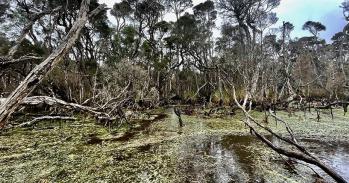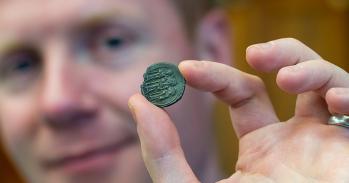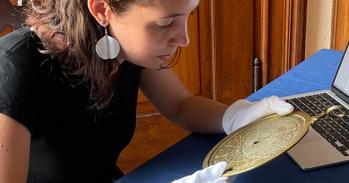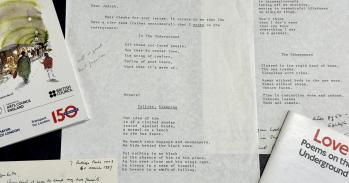
Six months after she set forth on an epic tour of Iceland in a Land Rover ambulance on the trail of the country’s medieval sagas, Dr. Emily Lethbridge will be giving a free, public lecture in Cambridge this week to update her followers on the story of her project so far.
Six months after she set forth on an epic tour of Iceland in a Land Rover ambulance on the trail of the country’s medieval sagas, Dr. Emily Lethbridge will be giving a free, public lecture in Cambridge this week to update her followers on the story of her project so far.
It’s hard to think of an analogy in another country where a corpus of medieval literature is so close to people’s hearts.
Emily Lethbridge
In January 2010, University of Cambridge researcher Dr Emily Lethbridge set off on a pilgrimage to Iceland to work on the country’s medieval sagas ‘in situ’. She took with her editions of the sagas, detailed maps, some basic information about fishing and emergency first aid, and, most notably, a decommissioned Ministry of Defence Land Rover ambulance, in which she has been living ever since.
Six months into her journey of discovery around the country, she has already uncovered more than she bargained for. Iceland's sagas, it turns out, are not only alive and well in the national consciousness but in some cases, still evolving as they are transmitted afresh, hundreds of years after they were first written down.
The year-long project is only half complete, but Emily is paying a flying visit back to the UK this week and will be giving a free, public talk on Thursday about her experiences so far, hosted by the University's Department of Anglo-Saxon, Norse and Celtic.
Originally written down in the 13th and 14th centuries, there are more than 30 sagas of Icelanders (ĺslendingasögur) in all. They describe the lives of the families who first settled Iceland in the late 9th and early 10th centuries, and those of their descendants in the 11th century.
Even today, they are a central part of Iceland's culture and still taught in its schools. Most people are familiar with a good number, if not all of them. The sagas are certainly known to a much greater extent than British people are familiar with famous works of medieval literature, such as Chaucer’s Canterbury Tales.
To understand more about why and how the sagas have such an enduring place in Icelandic consciousness, Emily has been exploring the country in her ambulance, and reading and studying each saga in the landscape in which it is set. On the way, she has been avidly blogging about her experiences to a growing audience of enthusiasts around the world.
She believes that one key to understanding the power of the sagas lies in their relationship with the landscape itself. The sagas explain how place-names all around the country came to be. Some of their explanations about events and characters that purportedly gave rise to the names of places – like farms, hills, bogs and other natural features – may have a historical basis. Others may have been invented by a saga-author.
Despite their age, the sagas still live on in many of the local areas in which they are set – and have a life over and beyond the printed page. They are used as inspiration for modern literary works, art and music, and they are creatively engaged with on a more everyday basis as well, by people who are not writers or artists.
“I have come across farmers who compose one-off verses about characters, events, places in the sagas—just for the fun of it”, Emily says. “The knowledge that people who are not academics or specialists have about the sagas is remarkable, and I’m learning a lot from being exposed to this, and listening to local people’s opinions about ‘their’ saga. It’s hard to think of an analogy in another country where a corpus of medieval literature is so close to people’s hearts on a local and national scale.”
One reason for this, she thinks, lies in the way that regardless of whether or not they are historically ‘accurate’, the sagas present accounts of the comprehensive settling of a previously uninhabited island. The sagas are medieval attempts to map the early settlers’ stamping of their identity on to this previously empty and nameless space.
In this sense, Emily’s research is not just about the power of sagas as literature, but the power of history and legend as a means of constructing and expressing local and national identity: “Humans everywhere need context and strive to understand and have a grip on the past. Over the past millennium or so, the extent to which the landscape in Iceland has changed or been built upon is negligible compared to Britain, for example. In some ways, in the Icelandic landscape, the past is much closer to the present than in other places.”
"When related directly to their physical context, the sagas can be ‘read’ as something other than linear narratives that move from chapter to chapter," she adds. "As one moves from one place to another in a particular area, place-names trigger the recollection of an anecdote related in one saga (and sometimes multiple sagas), and these combine to form a bigger narrative - about a local district, and about the country and its people."
Emily will be heading back to Iceland to continue her research early next week. Her talk, on Thursday, 16 June, will take place in Room GR-06/07 the Faculty of English, West Road, Cambridge, at 5pm. You can also follow her adventures at https://sagasteads.blogspot.com/
This work is licensed under a Creative Commons Licence. If you use this content on your site please link back to this page.





